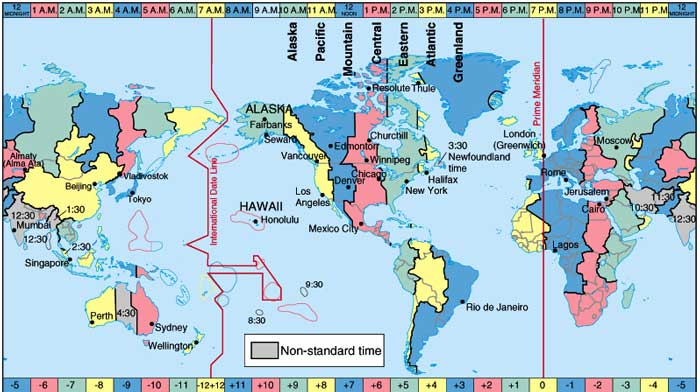
Time zones and longitude are interchangeable. Time zones, in fact, are defined by the rotation of the Earth, which turns a full circle (360 degrees) each day (24 hours). Each hour then, Earth rotates through 360/24 = 15 degrees of longitude. For continuity in human experience -- meaning that wherever you go on Earth, the sun is near its highest point in the sky at noon -- the nations of the world agreed on a unified time system. Each time zone is 15 degrees wide, but some are stretched in various ways to accommodate the world's political boundaries as shown below.
The bottom scale on the figure gives the hour difference between the Prime Meridian in England at 0° longitude and time zones around the world. The upper scale gives an example of how time varies over the earth at a specific moment, in this case when the time at the Prime Meridian is 7 PM. An important point to note in the figure is that at places to the east of a given location, the time is later, and at places to the west the time is earlier. Also note that time zones are centered on longitude multiples of 15° (30°, 45°, 60° etc...) and extend 7.5° westward and eastward from this meridian.

Use the information above to determine the difference in hours between the following locations (Hawaii is in the +10 time zone): (Note: ignore Daylight Savings Time for 33 through 48)
33. ______ Hawaii and Greenwich, England
34. ______ Sydney and Perth
35. ______ Hawaii and Tokyo
36. ______ Hawaii and Los Angeles
37. ______ Moscow and New York
38. ______ Moscow and Greenwich, England
39. ______ Moscow and Cairo
Assume the time in Hawaii is 10 pm, what is the time in
40. ______ Los Angeles
41. ______ Tokyo
42. ______ Greenwich, England
Assume the time in Hawaii is 5 am, what is the time in
43. ______ Los Angeles
44. ______ Tokyo
45. ______ Greenwich, England
46. ______ Moscow
One more thing: the International Date Line, an artifact of the time zone system required in order to have a location where each day begins and ends. It's pretty easy: when you cross it moving west (from Hawaii to Tokyo for example) add 24 hours to your time. When you cross it going east, subtract 24 hours from your time.
47. If it is 9 PM on Monday in Hawaii, what is the time and day in Tokyo?
_______________________
48. If it is 8 AM on Thursday in Tokyo, what is the time and day in Hawaii?
_______________________